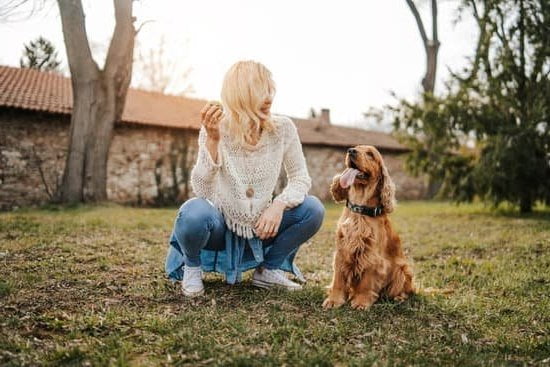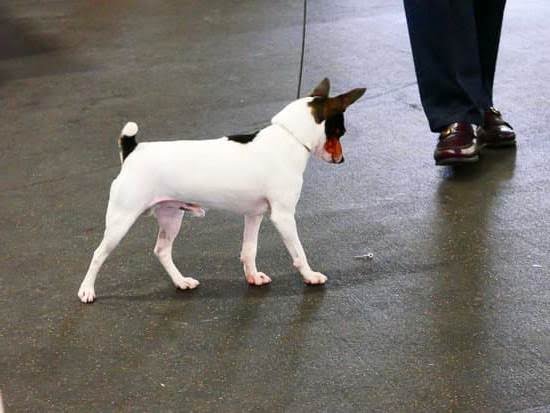Training your dog to give his paw is not only an adorable trick, but it also serves as a valuable skill that strengthens the bond between you and your furry friend. This simple gesture showcases your dog’s ability to follow commands and shows off his intelligence and obedience. Whether you’re looking for a new party trick or hoping to improve communication with your dog, teaching him to give his paw is a fantastic place to start.
By training your dog to give his paw, you are giving him the opportunity to learn and practice both physical and mental stimulation. This skill requires concentration, coordination, and focus from your dog, which can help improve his overall obedience and understanding of commands. Additionally, through positive reinforcement training methods, teaching your dog to give his paw can also be an incredibly rewarding experience for both of you, deepening the trust and connection between you.
Not only does teaching your dog this basic command have its practical applications in everyday life situations such as greeting guests or handling vet visits, but it can also be a great way for you both to engage in relationship-building exercises. The joy that comes from successfully completing a command and seeing the happiness on your dog’s face is immeasurable – it is a testament to the bond that has been nurtured through training.
So let’s dive into how positive reinforcement techniques coupled with patience can help you achieve success in teaching your beloved pet how to give his paw.
Understanding the importance of positive reinforcement in dog training
Positive reinforcement is a key component of effective dog training, and it plays a vital role in teaching your dog to give his paw. Understanding the power of positive reinforcement can help make the training experience enjoyable and successful for both you and your pup.
Why positive reinforcement?
Positive reinforcement involves rewarding your dog for desired behaviors, such as giving his paw. This approach focuses on encouraging and motivating your dog rather than using punishments or force. By reinforcing good behavior with rewards, you create an environment where your dog associates the action of giving his paw with something positive – whether it’s praise, treats, or playtime.
The benefits of positive reinforcement
Using positive reinforcement in dog training has numerous benefits. Firstly, it enhances communication between you and your dog. When your dog understands that giving his paw results in rewards, he becomes more receptive to learning and is motivated to repeat the behavior.
Secondly, positive reinforcement builds trust and strengthens the bond between you and your furry companion. Your dog learns to associate training sessions with fun experiences and a chance to engage with you in a positive way.
Lastly, positive reinforcement has been proven to be more effective than punishment-based methods. Dogs trained using positive reinforcement are happier learners who are more likely to maintain their learned behaviors in the long run.
Choosing appropriate rewards
When using positive reinforcement during training, it’s important to choose appropriate rewards that motivate your dog. Every dog is different, so experiment with different types of rewards such as small treats, verbal praise, petting or favorite toys. Observe what drives your pup the most and use those rewards consistently during the training process.
Remember that consistency is key when utilizing positive reinforcement. Rewarding immediately after your dog gives his paw helps reinforce the connection between the behavior and reward. Be generous with praises and treats initially to reinforce the behavior strongly before gradually phasing out rewards over time.
By understanding the importance of positive reinforcement in dog training, you lay the foundation for successful training sessions with your furry friend. With this knowledge in mind, you can now move forward to preparing for training and building a strong foundation of basic obedience commands before teaching your dog to give his paw.
Preparing for training
Before you begin training your dog to give his paw, it is important to gather all the necessary tools and create a conducive environment for learning. By being prepared, you can set both you and your dog up for success in the training process.
The following are some essential tools you will need for training your dog to give his paw:
- Treats: High-value treats are an effective tool for positive reinforcement. Choose treats that are small, tasty, and appealing to your dog. These treats will serve as rewards for your dog when he successfully performs the desired behavior.
- Clicker or Marker Word: A clicker or marker word is a way to communicate with your dog that he has done something correctly and will receive a reward. This helps to reinforce the behavior you want him to learn. If you decide to use a clicker, make sure to practice using it before starting the training session.
- Leash and Collar/Harness: It may be helpful to have your dog on a leash during the initial stages of training. This allows for better control and prevents distractions during the training session.
In addition to gathering these tools, it is important to create a conducive environment for learning:
- Choose a quiet location without distractions: Find a space in your home or yard where you can minimize external distractions. This will help your dog stay focused on the training session.
- Set aside enough time: Training sessions should be short but frequent, ranging from 5-10 minutes each day. Make sure you have enough time available so that you do not feel rushed during the training process.
- Remove any physical barriers: Make sure there are no objects or furniture blocking the area where you will be conducting the training session. Creating an open space will allow your dog to move freely as he learns the new skill.
By gathering these necessary tools and creating a conducive environment, you are ready to embark on the training journey with your dog. Remember to be patient and consistent in your training efforts, as this will contribute to the success of teaching your dog to give his paw.
Building a strong foundation
Building a strong foundation in obedience training is crucial when teaching your dog to give his paw. Before you can expect your dog to understand and perform more complex behaviors, such as giving his paw, he should have a solid understanding of basic obedience commands. This section will outline the key obedience commands that you should teach your dog before moving on to teaching him to give his paw.
The first command you should teach your dog is “sit.” This command is relatively easy for most dogs to learn and it sets the foundation for many other behaviors. Start by holding a treat close to your dog’s nose and slowly lifting it upwards. As your dog’s head goes up, his bottom will naturally lower into a sitting position. Once his bottom touches the floor, say “sit” and immediately reward him with the treat and praise.
The second command is “down,” which teaches your dog to lie down on command. Start with your dog in a sitting position and hold a treat in front of him near his nose. Slowly move the treat downwards towards the ground between his paws. As he follows the treat with his nose, his body will naturally lower into a lying down position. Once he is fully lying down, say “down” and reward him with the treat and praise.
Lastly, it’s important to teach your dog the command “stay.” This command helps develop impulse control and teaches your dog to remain in one spot until released. Start by asking your dog to sit or lie down, then hold up an open palm in front of their face like a stop sign while saying “stay.”
Take a step back away from your dog, then quickly return and reward them for staying in place. Gradually increase the distance between you and your dog as they become more comfortable with staying in place.
By teaching these basic obedience commands first, you are setting a strong foundation for advanced training behaviors like giving their paw. Remember to always use positive reinforcement techniques, such as treats and praise, to motivate and reward your dog for successfully performing these commands. With a solid foundation in obedience, you’ll be ready to move on to the next step of teaching your dog to give his paw.
Step-by-step guide to training your dog to give his paw
When training your dog to give his paw, it’s important to start with capturing and shaping the behavior. This method utilizes positive reinforcement and involves rewarding your dog for naturally offering the behavior you desire. Here is a step-by-step guide to help you train your dog to give his paw:
Capturing the behavior
- Begin by observing your dog for any natural instances where he lifts his paw or touches an object with his paw.
- When you see your dog perform this behavior, immediately praise him and provide a treat as a reward.
- Repeat this process each time your dog lifts his paw or touches an object with it, until he starts to understand that this behavior is desirable.
Shaping the behavior
- Once your dog understands that lifting his paw is rewarded, add a verbal cue such as “paw” or “shake” when he performs the behavior.
- After giving the verbal cue, wait for your dog to lift his paw on his own before rewarding him.
- Gradually increase the criteria by only rewarding your dog when he lifts his paw higher or holds it up for longer periods of time.
- As your dog continues to improve, start introducing a hand signal along with the verbal cue, such as reaching out with your hand open.
- Eventually, phase out the capturing process and use only the verbal cue and hand signal to prompt your dog to give his paw.
Remember that consistency is key when training your dog. Practice these steps several times a day in short sessions, gradually increasing the difficulty level as your dog becomes more comfortable with giving his paw on command. Take note of any challenges or setbacks that may occur during training and adjust accordingly.
In the next section of this article, we will address some common challenges that may arise during the training process and provide troubleshooting tips to overcome them effectively.
Troubleshooting common challenges during the training process
Training your dog to give his paw can be an enjoyable and rewarding experience, but it doesn’t come without its challenges. In this section, we will discuss some common challenges that dog owners may face during the training process and provide helpful troubleshooting tips.
One common challenge is when a dog becomes uninterested or distracted during training sessions. This can happen if the training sessions are too long or repetitive, causing the dog to lose focus. To overcome this challenge, it is important to keep training sessions short and engaging. Use high-value treats or toys as rewards to keep your dog motivated and interested in the training.
Another challenge that dog owners often encounter is when their dogs refuse to lift their paw or perform the desired behavior. This can be due to a fear of having their paws touched or manipulated. It is crucial to create a positive association with touching their paws by gradually desensitizing them to it.
Start by gently touching their paws for a brief moment and immediately rewarding them with treats and praise. Gradually increase the duration of touch and reward them consistently until they become comfortable with having their paws handled.
Some dogs may also exhibit resistance or stubbornness during the training process. They might refuse to give their paw or display other unwanted behaviors such as biting, growling, or pulling away. In such cases, it is important not to punish or scold your dog as this can create anxiety and hinder progress. Instead, take a step back and revisit basic obedience commands to reinforce trust and build a positive relationship with your furry friend.
| Challenge | Troubleshooting Tip |
|---|---|
| Lack of interest/distracted | Keep training sessions short and engaging; use high-value rewards |
| Fear of having paws touched | Desensitize gradually; start with brief touches and reward consistently |
| Resistance or stubbornness | Revisit basic obedience commands; avoid punishment and reinforce trust |
Remember, each dog is unique and may respond differently to training. Be patient, consistent, and understanding throughout the process. With perseverance and positive reinforcement, you can overcome these challenges and successfully train your dog to give his paw.
Expanding the skill
Once your dog has mastered the basic skill of giving his paw, it’s time to expand his abilities by teaching him to do it on command in various scenarios. This will not only impress your friends and family but also make your dog more adaptable and responsive in different situations.
To start this advanced training, choose a specific command word or hand signal that you will use consistently whenever you want your dog to give his paw. It could be something simple like “Paw” or “Shake.” Make sure everyone in the household uses the same command to avoid confusion for the dog.
Next, begin by practicing the skill with distractions present. Start in a quiet area without distractions and gradually introduce more challenging environments. For example, train your dog to give his paw outdoors where there might be new sounds, smells, or other animals. This will help your dog learn to focus on your command despite any distractions around him.
Another important scenario to practice is when meeting new people. Teach your dog to offer his paw as a friendly greeting when someone extends their hand for a handshake. This is not only polite but also a great way for your dog to interact positively with strangers.
To reinforce this behavior in various scenarios, ensure that you continue using positive reinforcement techniques such as treats and praise whenever your dog successfully gives his paw on command. Consistency is key here, so make sure you reinforce the behavior every time he performs it correctly.
Lastly, remember that training should always be fun for both you and your furry friend. Incorporate playtime into practice sessions or teach new variations of giving the paw, such as high-five or fist bump. These fun variations can keep your training sessions engaging and entertaining for both you and your dog.
| Training Scenario | Description |
|---|---|
| Outdoors | Train your dog to give his paw in outdoor environments with distractions present. |
| Meeting new people | Teach your dog to offer his paw as a friendly greeting when meeting new people. |
| Variations | Incorporate variations of giving the paw, such as high-five or fist bump, to keep training sessions fun and engaging. |
Reinforcing and maintaining the behavior
Once your dog has learned to give his paw on command, it is important to reinforce and maintain this behavior so that he continues to do it reliably. Here are some tips to ensure that your dog maintains this skill:
- Consistency is key: Make sure to consistently ask your dog to give his paw in various situations and environments. This will help solidify the behavior and ensure that he understands that giving his paw is a regular expectation.
- Continue with positive reinforcement: Continue using positive reinforcement techniques such as praise, treats, or toys as rewards when your dog gives his paw. This will keep him motivated and eager to display the behavior.
- Gradually phase out treats: While treats can be helpful during the training process, it is important to gradually reduce their use over time. Once your dog consistently offers his paw without needing a treat every time, you can start phasing out the treats and relying more on verbal praise or other rewards such as playtime.
- Practice in different settings: It is important to practice asking for your dog’s paw in different settings and scenarios. This will help generalize the behavior so that he understands to offer his paw no matter where you are or what distractions may be present.
- Maintain short training sessions: Dogs have short attention spans, so it is important to keep training sessions short and engaging. Aim for multiple mini-sessions throughout the day rather than one long session. This will help keep your dog focused and interested in learning.
- Be patient and consistent: Remember that training takes time and patience. It may take some time for your dog to fully understand and consistently offer his paw on command. Stay consistent with your training methods and remain patient throughout the process.
By following these tips, you can ensure that your dog continues to give his paw reliably even after he has mastered the skill. Maintaining consistency, using positive reinforcement, varying training settings, and practicing regularly will help strengthen the behavior and deepen the bond between you and your furry friend.
Fun variations to teach your dog after he has mastered giving his paw
Once your dog has successfully learned the basic command of giving his paw, you can start exploring fun variations to keep the training sessions interesting and engaging for both you and your furry friend. These variations not only provide mental stimulation for your dog but also strengthen the bond between you and your canine companion.
- High Five: This variation is a natural progression from teaching your dog to give his paw. Encourage your dog to raise his paw higher so that it touches your hand above waist level. You can use a verbal cue such as “high five” or “up” while offering your palm as a target.
Reward your dog with treats and praise when he successfully raises his paw to touch your hand. Gradually increase the height at which you want him to raise his paw. - Fist Bump: Adding this fun trick will surely impress friends and family. Begin by shaping the behavior of touching their closed fist with their nose or paw. Place your closed fist slightly lower than shoulder level and use a verbal cue like “fist bump” or “pound it.”
When your dog touches their nose or paw against your fist, reward them with treats and praise. Be patient during this process, as not all dogs will understand the new concept right away. - Wave Goodbye: Teaching your dog how to wave goodbye is an adorable trick that can bring joy to anyone who witnesses it. Start by using a visual or verbal cue such as waving your own hand while saying “wave” or raising one of their paws while saying “wave.”
Capture any movement resembling a wave with positive reinforcement, rewarding them immediately after they lift their paw. With consistent practice, gradually shape the behavior until they are raising their paw in response to the cue every time.
Remember, consistency, patience, and positive reinforcement are key throughout these variations just as they were during the initial training. Always use rewards that motivate and excite your dog, such as small treats or their favorite toy. Training sessions should be short and frequent to keep your dog engaged. Keep practicing these fun variations, and soon you’ll have a repertoire of adorable tricks that will make your dog the star of any gathering.
Conclusion
Training your dog to give his paw is not only a valuable skill, but it also strengthens the bond between you and your furry friend. Throughout the training process, you have learned about the importance of positive reinforcement, gathering the necessary tools, and creating an environment conducive to learning. Additionally, you established a strong foundation by teaching your dog basic obedience commands before moving on to teaching him to give his paw.
Step-by-step, you have followed a guide to capture and shape the behavior of your dog giving his paw. You may have encountered some challenges along the way, but troubleshooting those obstacles has helped you both grow and develop as a team. With persistence and patience, you can expand this skill by teaching your dog to give his paw on command in various scenarios.
Reinforcing and maintaining this behavior is crucial for ensuring long-term success. By following tips such as continuous positive reinforcement and regular practice sessions, you can ensure that your dog continues to reliably give his paw when asked. It’s important to celebrate each accomplishment during the training process and embrace the bond that has been created through this shared experience.
Now that your dog has mastered giving his paw, there are fun variations that you can explore together. Experiment with new tricks or consider competing in obedience competitions where your dog’s newfound skill can be showcased. Remember to always keep training sessions positive and enjoyable for both of you.
In conclusion, training your dog to give his paw is an achievement worth celebrating. Not only does it demonstrate a well-trained companion, but it also strengthens the bond between owner and pet.
The journey from capturing and shaping behavior to expanding the skill may present challenges, but with persistence and dedication, success is attainable. Embrace this accomplishment as a testament not only to your dog’s abilities but also as a testament to the love and connection formed throughout the training process.
Frequently Asked Questions
How long does it take to teach a dog to give paw?
The time it takes to teach a dog to give paw can vary depending on several factors. These factors include the individual dog’s temperament, age, previous training experience, and the consistency of training sessions.
Generally, teaching a dog to offer their paw can take anywhere from a few days to several weeks. It is important to approach the training process with patience and positivity, breaking down the behavior into small steps and gradually reinforcing and rewarding the desired action.
Why won’t my puppy give me his paw?
If your puppy is not giving you his paw when asked, there could be a few reasons behind this behavior. Firstly, it is possible that your puppy hasn’t been properly introduced or exposed to this command yet. Puppies need time to learn new behaviors and may not understand what is expected of them initially.
Additionally, it is important to consider their age and developmental stage – some puppies might be too young or physically uncoordinated to comfortably offer their paw. Lastly, if your puppy appears hesitant or fearful when you try to touch or handle their paws, there might be an underlying issue such as pain or discomfort that needs addressing before they feel comfortable extending their paw.
Is it good to teach your dog paw?
Teaching your dog how to give paw can generally be considered beneficial for both you and your furry companion. Firstly, it serves as a fun way to engage with your pet while providing mental stimulation during training sessions. Furthermore, teaching basic commands like giving paw fosters communication between you and your dog, enhancing the bond you share.
Additionally, this specific behavior can have practical applications in daily life; for example, teaching your dog to give paw can make grooming routines easier by accustoming them to having their paws handled without distressing them. Overall, teaching your dog various skills including giving paw allows them to learn new things and helps establish a well-behaved canine citizen within your household.

Welcome to the blog! I am a professional dog trainer and have been working with dogs for many years. In this blog, I will be discussing various topics related to dog training, including tips, tricks, and advice. I hope you find this information helpful and informative. Thanks for reading!





